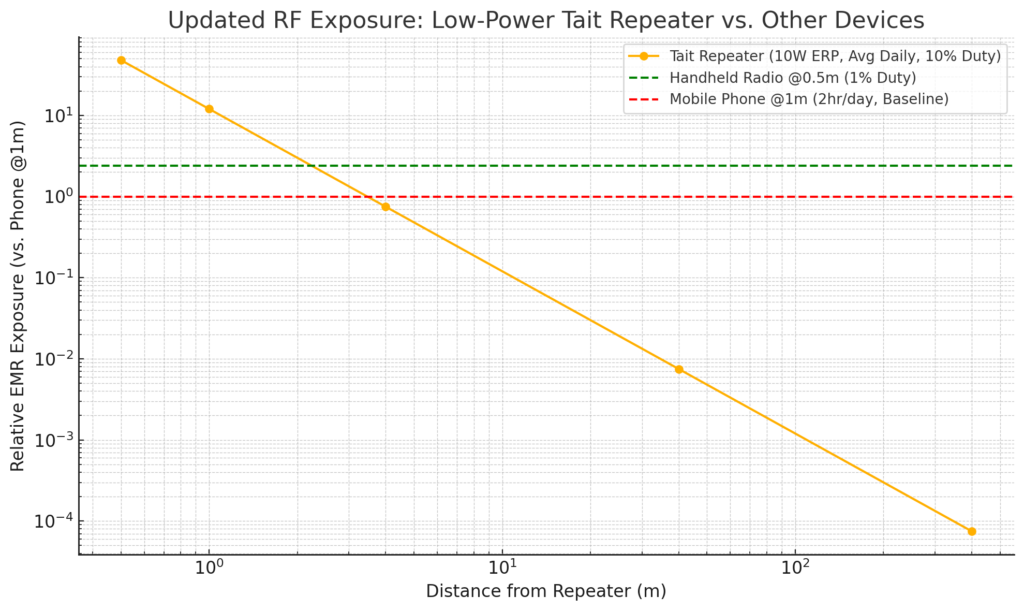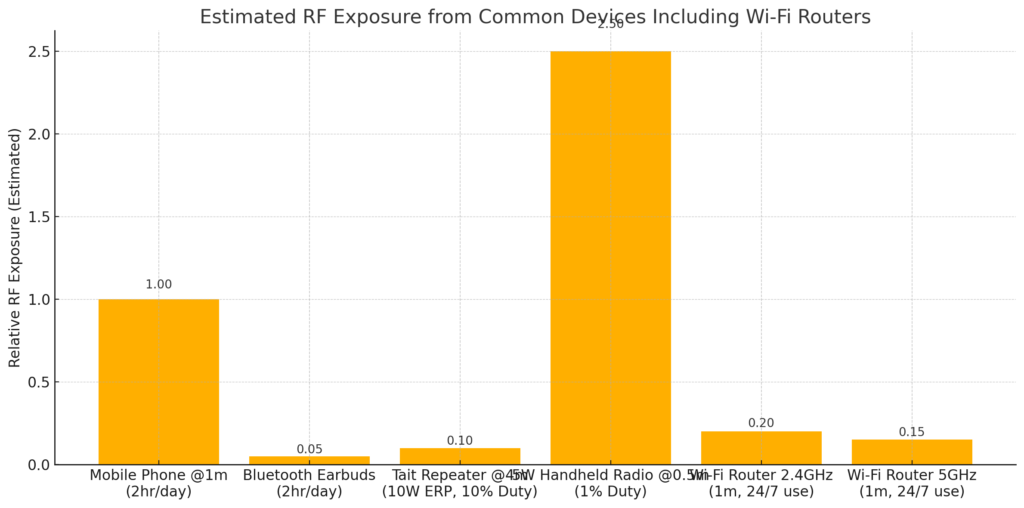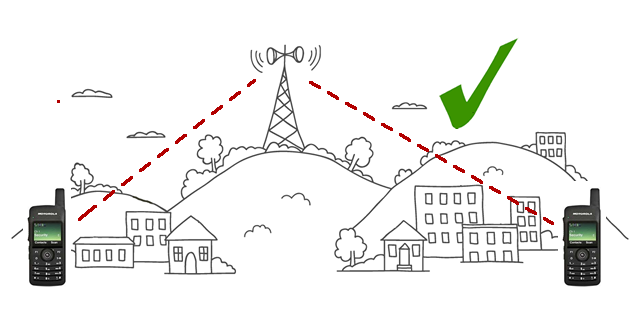UHF Repeater Installations
This document provides a simple, science-backed overview of RF (radiofrequency) exposure from Ultra High Frequency (UHF) repeaters such as the Tait Link Repeater. It addresses common concerns in communities regarding the safety of radio infrastructure.
Q: What is UHF and is it dangerous?
A: UHF (Ultra High Frequency) is part of the radio spectrum, used for communication devices like repeaters, mobile phones, and TVs. It is a form of non-ionizing radiation, meaning it does not carry enough energy to damage DNA or cells. At typical exposure levels, UHF is considered safe.
Q: What is the RF output of the Tait UHF repeater?
A: The Tait repeater operates at 450 MHz with a transmitter output power of 5 watts and an antenna gain of 3 dBi, resulting in an effective radiated power (ERP) of 10 watts. This is a relatively low-power setup, suitable for local coverage and minimal RF exposure risk.
Q: Does RF exposure from a repeater cause cancer or other health problems?
A: According to the World Health Organization (WHO), International Commission on Non-Ionizing Radiation Protection (ICNIRP), and national health bodies (e.g., ARPANSA in Australia), there is no credible evidence that low-level RF exposure causes cancer or other health issues.
Q: How does RF exposure from a repeater compare to using a mobile phone or Bluetooth?
A: Even at a distance of just 4 meters, the RF exposure from this repeater is 10× lower than from a mobile phone used 2 hours a day at 1 meter. At 40 meters, the exposure is 0.1%, and at 400 meters, it is 0.001% of that same baseline. A 5W handheld radio used near the head still produces higher localised exposure than the repeater, even at just 1% duty cycle.
Q: What about long-term exposure from living near a repeater?
A: Even long-term exposure from nearby repeaters has not been shown to cause harm, provided safety guidelines are followed. The power density from repeaters drops off rapidly with distance, and antennas are typically mounted well above human access zones.
Q: Are there safety limits in place?
A: Yes. International and national standards (like ICNIRP and ARPANSA) set strict exposure limits. The repeater system installed in your community operates well within these limits, with large built-in safety margins.
Q: Where can I learn more?
A: Visit trusted sources like:
– World Health Organization (WHO): who.int
– ARPANSA (Australia): arpansa.gov.au
– ICNIRP: icnirp.org
Handheld Radios, Repeaters, and Phones
Q: Is it safe to use a 5W handheld radio near my head?
A: Yes, it is safe when used properly. A 5W UHF radio at 0.5 meters from your head—even at just 1% duty cycle—results in RF exposure that is 2–3 times higher than a mobile phone on a desk 1 meter away during 2 hours of use. However, it is still well within international safety limits, such as those set by ICNIRP and ARPANSA. Using a speaker mic or holding the radio further from your head can reduce exposure significantly.
Q: How does RF exposure from the Tait repeater at 10 meters compare to a Wi-Fi router at 10 meters?
A: At 10 meters distance, RF exposure from both the Tait repeater (10W ERP, 10% duty cycle) and a typical home Wi-Fi router (2.4 or 5 GHz, 24/7) is extremely low—likely less than 1% of the exposure from a mobile phone held at 1 meter during a 2-hour call. The repeater transmits intermittently and directionally, while the Wi-Fi router emits lower power but continuously. At this range, both sources are considered negligible from a health perspective and well below any regulatory safety limits.
Q: Is a mobile phone more dangerous than a handheld radio?
A: Mobile phones operate at lower power (typically 0.2–1W), but they are often held directly against the head or carried in pockets. Their higher frequency and long daily use (especially for data and voice calls) can result in comparable or higher localized exposure than a short radio transmission.
Q: What is a duty cycle and why does it matter?
A: Duty cycle refers to the percentage of time a device is actually transmitting. For example, if a repeater transmits 10% of the day, or a handheld is only used 1% of the time, the average daily exposure is much lower than continuous transmission would suggest. This is important for evaluating real-world RF impact.
Q: Are these devices within safety limits?
A: Yes. All RF equipment referenced—handheld radios, repeaters, and phones—operate well within safety limits set by regulatory bodies such as ARPANSA (Australia) and ICNIRP (international). These limits include large safety margins and are regularly reviewed based on the latest science.

Bar chart comparing estimated RF exposure from:
• A mobile phone at 1m for 2 hours/day (baseline = 1.0)
• Bluetooth earbuds used 2 hours/day (~0.05)
• The Tait repeater at 4m, 10W ERP, 10% duty (~0.1)
• A 5W handheld radio at 0.5m, 1% duty (~2.5)
This visualization clearly shows that:
• The handheld radio has the highest localized exposure.
• The Tait repeater is well below phone levels, even at 4 meters.
• Bluetooth is negligible by comparison.
• Wifi router is similar to Bluetooth and the Repeater.

